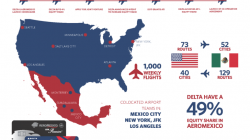In late 2016, the US Department of Transportation put the kibosh on a proposed American Airlines – Qantas anti-trust immunity agreement (ATI). The purpose of achieving ATI was to enable both carriers to revenue-share on flights between the U.S. and Australia and New Zealand.
For joint venture tie-ups to present a strong business case for approval, the DOT must conclude that the agreement (1) does not substantially reduce or eliminate competition and (2) is consistent with public interest. In the DOT’s eyes, per point number one, Qantas and American were, and are, competitors, and hypothetically, would control 59% of the US – Australia market if they were permitted to operate as one airline across the Pacific.
However, American was very vocal in 2017 that it would try again when the U.S. Presidential Administration changed, hoping that the success of Delta’s joint venture partnership with Korean Air would be a precursor to American and Qantas receiving the same level of approval.
The estimated impact of ATI would be roughly $310 million in consumer benefits, improved connections, schedule frequency, and lower connecting fares, according to The Dallas Morning News.
In a twist of events, however, American is resorting to some of its classic chest-beating tactics by alleging that without an expanded agreement, Qantas’ DFW-Sydney nonstop flight might be reduced in frequency, or even canceled by Qantas. There would also be reductions in codeshare and the number of flights offered between the two regions, with American pulling Qantas’ codeshare on all domestic flights out of LAX and a reduction of codeshare destinations by 50% from SFO, unless the joint venture is approved.
There are a lot of emotional measures being employed here by American and Qantas to make some noise in front of the DOT. I see arguments on both sides of the matter, but ultimately, I think that my position stands the same: The DOT should basically give-in to American and Qantas, because in the end, it’s not all that huge of a market.
Here are my justifications:
The Australia market is important for American, and the U.S. market is important for Qantas. Purportedly, Qantas has done very well since they started servicing DFW in 2011, and has stated ambitions to add more links from DFW to secondary markets like Melbourne and Brisbane using 787-9s.
Both airlines have risen from positions of weakness 5-7 years ago to positions of massive strength, and in situations like this, where airlines have a strong historical market presence, via their own metal or through virtual means, it is silly to hinder them from building on momentum and scale.
American has also been able to add new routes from LAX to Sydney and Auckland in hopes of cementing the JV aspirations with Qantas. While the acts of American (and Qantas) threatening to cull routes and codeshares is likely posturing, it still looms large enough to create adversarial economic impact.
American and Qantas’ largest regional competitors, Delta and United in the U.S., and Virgin Australia and Air New Zealand in Oceania, have joint venture agreements on transpacific flights. Delta has one with Virgin Australia, and United has one with Air New Zealand. Much like how American was locked out from having metal neutrality with British Airways for the longest time on transatlantic routes, there should be no reason why its excluded from Australia.
American and Qantas’ presence in the U.S. – Australia market has not prevented other competitors from entering. United has launched Houston-Sydney and San Francisco-Auckland service, while Virgin Australia has added Los Angeles-Melbourne service.
So there needs to be some clear, rational thought on the DOT’s part with this next round. But even more importantly, should the DOT rule against the joint venture, it must provide greater transparency surrounding the logic behind such a denial. Last time, the public was issued extremely minute details on why the JV failed to pass. Given this, combined with the relatively smooth-sailing of the joint venture between Delta and Korean Air it would be a horrible precedent for the DOT to set if they failed to offer up more information.




